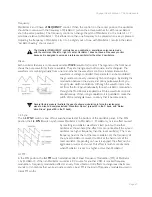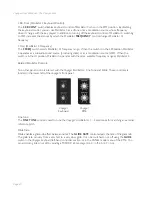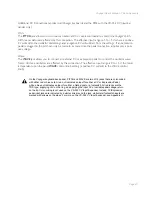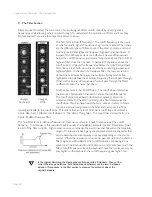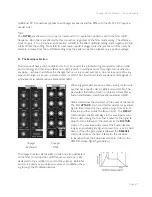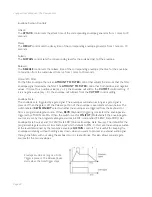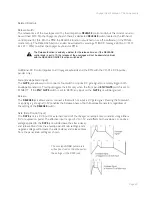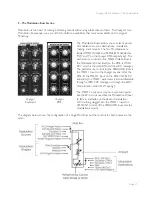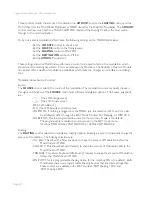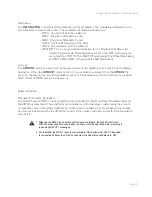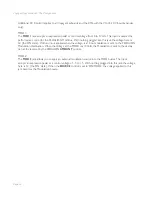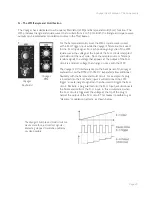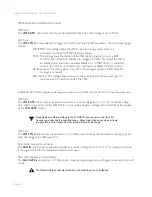
Page 20
Voyager User’s Manual - The Components
Page 21
Voyager User’s Manual - The Components
Frequency:
Oscillators 2 and 3 have a
FREQUENCY
control. When the control is in the center position, the oscillators
should be in unison with the frequency of Oscillator 1 (when the octave switches for all three oscillators
are in the same position). The Frequency control can change the pitch of Oscillator 2 or 3 a total of +/- 7
semitones relative to Oscillator 1. This allows more than one frequency to be played when a key is pressed.
Adjusting the frequency of Oscillator 2 & 3 to be slightly out of tune with Oscillator 1 results in the classic
“oscillator beating” chorus sound.
The Oscillator FREQUENCY controls have no calibration - sometimes unisons are made
with the controls a little left or right of center. Oscillator 1 does not have a Frequency control
because it is designed to serve as a reference oscillator for the other 2 oscillators.
Wave:
Each oscillator features a continuously variable
WAVE
(waveform) control. The legend on the front panel
shows the pure waveforms that are available. They are triangle, sawtooth, square, and rectangular. The
waveform is morphed gradually from one to another as the waveform control is rotated. Because the
waveform is voltage controlled, this parameter can be modulated;
this generates some very interesting timbral changes. By limiting the
modulation between the square and skinny pulse waveform, you
can get pulse width modulation. Although the waveforms can be
set from the front panel individually for each oscillator, modulation
through the Mod Busses is applied to all three waveform controls
simultaneously. When using modulation, it is possible to make the
width of the rectangular wave so skinny that it becomes silent.
1-2 Sync:
The
1-2 SYNC
switch is one of four switches located at the bottom of the oscillator panel. In the ON
postion, the
1-2 SYNC
switch synchronizes Oscillator 2 to Oscillator 1. Oscillator sync is an effect caused
by resetting an oscillator waveform’s start point with another
oscillator as shown here (the effect is more noticeable if the synced
oscillator is a higher frequency than the reset oscillator). The main
frequency heard is that of the reset oscillator. As the frequency of
the synced oscillator is swept, it reinforces the harmonics of the
reset oscillator. Depending on how it is applied, the effect can be
aggressive or warm and vocal. This effect is much more dramatic
when Oscillator 2 is set to a higher octave than Oscillator 1.
3-1 FM:
In the ON position, the
3-1 FM
switch establishes direct linear Frequency Modulation (FM) of Oscillator
1 by Oscillator 3. When an Oscillator is used as a CV source for another VCO, it is called frequency
modulation. Frequency modulation effects can vary from vibrato or trill effects to clangorous inharmonic
sounds to rich timbres that evoke acoustic sounds. Linear FM is the kind of frequency modulation used in
classic FM synths.
Several factory presets illustrate the use of extreme modulation to force the rectangular
wave to silence. Examples include “Waveform Dance” (preset 23 in the C bank, and “Relax-
ation Drone” (preset 89 in the D bank).















